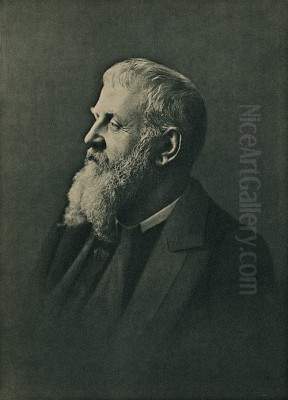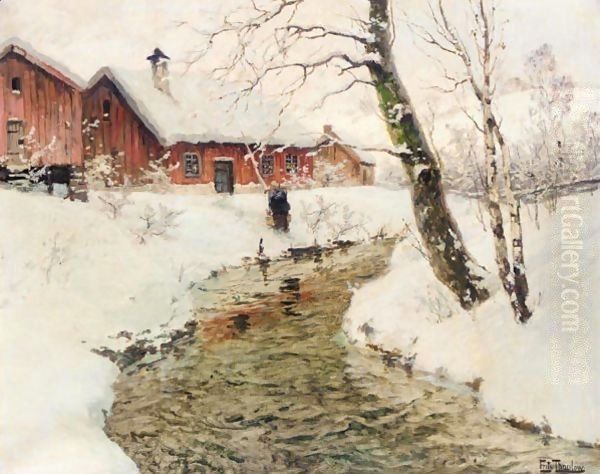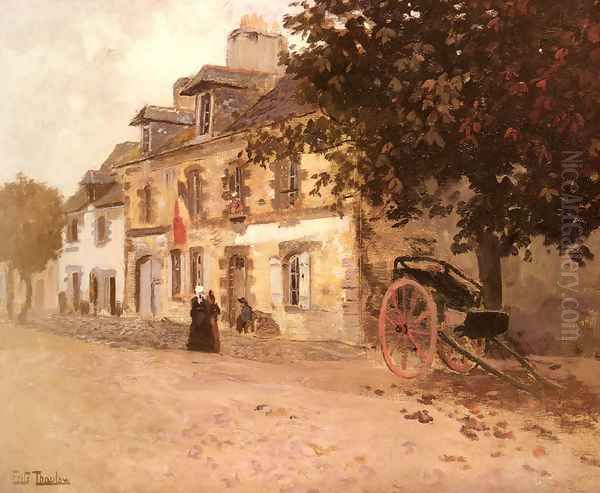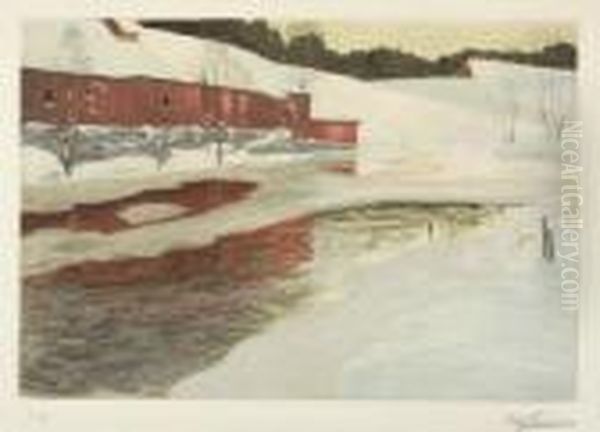
Johan Fredrik Thaulow, known to the art world as Fritz Thaulow, stands as one of Norway's most celebrated painters. Born in Christiania (now Oslo) on October 20, 1847, into a prosperous family, he carved a significant niche for himself within the European art scene of the late 19th and early 20th centuries. Primarily recognized as an Impressionist landscape painter, Thaulow possessed an extraordinary ability to capture the transient effects of light, particularly on water and snow. His work bridged the gap between Norwegian Naturalism and French Impressionism, earning him international acclaim and a lasting legacy. He passed away in Volendam, the Netherlands, on November 5, 1906, leaving behind a rich body of work that continues to enchant viewers.
Early Artistic Pursuits and Education
Thaulow's initial artistic inclinations steered him towards the sea. He harbored ambitions of becoming a marine painter, a path reflected in his early training. From 1870 to 1873, he pursued formal studies at the Royal Danish Academy of Fine Arts in Copenhagen. This period laid the foundation for his technical skills. Following his time in Copenhagen, he sought further instruction in Germany, enrolling at the Baden School of Art in Karlsruhe between 1873 and 1875. There, he likely studied under Hans Gude, another prominent Norwegian landscape painter known for his Düsseldorf school influences, although Thaulow would soon depart from this more traditional style.
His specific training in marine painting intensified in 1875 when he studied under the guidance of the noted Danish marine specialist, Carl Frederik Sørensen. This mentorship honed his ability to depict the nuances of the sea, ships, and coastal environments. However, Thaulow's artistic journey was one of evolution. While the sea remained a recurring element in his work, his focus gradually shifted towards landscapes, particularly the interplay of light and water in rivers, canals, and winter settings. This transition was significantly influenced by his later experiences and encounters with burgeoning art movements across Europe.
The Skagen Experience

A pivotal moment in Thaulow's early career occurred in 1879. Accompanied by his friend and fellow artist Christian Krogh, a leading figure in Norwegian Realism, Thaulow traveled to Skagen. This remote fishing village at the northern tip of Denmark was rapidly becoming a magnet for artists drawn to its unique light and unspoiled scenery. Thaulow became one of the early members of what would become famous as the Skagen Painters colony.
Although perhaps not as permanent a fixture as artists like P.S. Krøyer or Michael Ancher and Anna Ancher, Thaulow's time in Skagen was influential. He absorbed the plein-air ethos and the focus on capturing natural light that characterized the group. The camaraderie and artistic exchange with Krogh and others undoubtedly stimulated his development. The Skagen experience reinforced his move towards Realism and Naturalism, emphasizing direct observation and a truthful depiction of the environment, albeit infused with his own developing sensitivity to atmosphere.
Leading Figure in Norwegian Art
Returning to Norway, Thaulow quickly established himself as a significant force in the national art scene during the 1880s. He became a leading figure among a generation of artists seeking to break away from the more conservative, Düsseldorf-influenced traditions that had previously dominated Norwegian art. Thaulow was instrumental in challenging the established art institutions and promoting newer, more modern approaches inspired by European trends, particularly French Realism and, increasingly, Impressionism.
His influence extended beyond his own painting. Thaulow played a crucial role in organizing the first Høstutstillingen (Autumn Exhibition) in 1882. This independent, artist-juried exhibition provided a vital platform for progressive artists, including himself, Christian Krogh, and Erik Werenskiold, to showcase their work outside the confines of the official salons. The Høstutstillingen became a cornerstone of the Norwegian art world, symbolizing the shift towards modernism. Thaulow's leadership during this period cemented his status as a pioneer, helping to shape the direction of Norwegian art for years to come.
Embracing France and Impressionism
Thaulow's artistic horizons expanded significantly through his engagement with France. He first visited Paris in 1887, and the city, along with the French countryside, would become central to his life and work. He spent considerable periods living and working in France, particularly during the 1890s when he largely settled there. This immersion exposed him directly to the currents of French art, most notably Impressionism.

He developed important friendships within the Parisian art world, counting the sculptor Auguste Rodin and the Impressionist master Claude Monet among his close associates. The influence of Monet's work, with its focus on capturing fleeting moments of light and color, is evident in Thaulow's increasingly luminous and atmospheric paintings. He also admired the French Realist Jules Bastien-Lepage, whose detailed yet sensitive depictions of rural life resonated with Thaulow's own interest in landscape and atmosphere. Furthermore, Thaulow had a significant family connection to the art world: he was a cousin of Paul Gauguin and reportedly encouraged Gauguin in his artistic pursuits.
Thaulow actively participated in the Parisian art scene, exhibiting his works in prestigious venues. He showed paintings at the 1889 Exposition Universelle, gaining international exposure. He also regularly submitted works to the Salons, including the progressive Salon de Champs-Mars (Société Nationale des Beaux-Arts) in the 1890s. His success in France was marked by critical acclaim and awards, including a prize at the Paris Salon in 1897 and eventually being named a Chevalier of the French Legion of Honour, recognizing his contribution to the arts.
Artistic Style: The Poet of Water
If one theme dominates Fritz Thaulow's oeuvre, it is water. He possessed an unparalleled gift for depicting water in its various forms – flowing rivers, placid canals, frozen streams, and reflective ponds. He was particularly drawn to rivers, painting them repeatedly throughout his career in Norway, France, and elsewhere. Works like Evening Mood by the River (Aftenstemning ved elven) exemplify his mastery in capturing the subtle interplay of light, reflection, and movement on the water's surface.
His technique involved careful observation combined with a fluid, often vigorous brushstroke that conveyed the energy of moving water. He paid meticulous attention to reflections, capturing the distorted images of trees, buildings, and skies mirrored in the water. Unlike some French Impressionists who dissolved form completely into light and color, Thaulow often retained a strong sense of structure and place, grounding his luminous effects in a tangible reality. This blend of Impressionist technique and Naturalist observation gives his water scenes a unique character – both visually dazzling and emotionally resonant.
His depictions of Venice, such as The Grand Canal in Venice, showcase his ability to apply his skills to urban water settings. He captured the unique atmosphere of the city, the interplay of light on water and architecture, and the bustling life of the canals. Whether depicting a quiet Norwegian stream or a grand Venetian waterway, Thaulow approached water with a sensitivity that earned him the reputation of being its "poet" in paint.
Master of Snow and Winter Light

Alongside his celebrated water scenes, Thaulow was a consummate painter of winter landscapes. He had a profound understanding of the unique qualities of light in snow-covered environments. His winter scenes are not merely depictions of cold and dormancy; they are studies in subtle color, soft light, and tranquil atmosphere. He excelled at capturing the muffled silence of a snowy day, the crisp air of a winter evening, or the gentle glow of sunlight on frozen surfaces.
Works often descriptively titled, such as Winter in Norway or River Scene in Winter, demonstrate his ability to render the texture of snow and ice with remarkable veracity. He used a nuanced palette, often employing blues, violets, pinks, and ochres to depict the shadows and highlights on the snow, challenging the misconception that snow is merely white. His brushwork in these scenes could range from broad strokes suggesting snowdrifts to delicate touches indicating frost or individual snowflakes.
Paintings like Snow Bay capture the serene beauty and quietude of the Nordic winter. He often included elements like timber-framed houses, small figures, or flowing water partially frozen over, adding points of interest and narrative suggestion to the landscapes. These winter scenes contributed significantly to his international reputation, offering viewers a glimpse into the atmospheric beauty of the Scandinavian climate, rendered with Impressionistic sensitivity.
Urban Landscapes and Village Scenes
While best known for his natural landscapes, Thaulow also frequently turned his attention to scenes incorporating human habitation. He painted numerous views of small towns, village streets, and even industrial structures, often situated near the rivers and waterways he loved. These works demonstrate his versatility and his interest in capturing the character of specific places.
His paintings of French villages, such as the descriptively titled Street in a Village in France, often depict quiet lanes, charming houses, and the gentle rhythm of rural life. He applied his characteristic focus on light and atmosphere to these scenes, capturing sunlight filtering through trees, reflections on wet cobblestones, or the warm glow of lamps in windows. These works possess a sense of intimacy and tranquility.
Even when depicting more industrial subjects, like factories situated along rivers (as suggested by the title The Factory Building Next to the Frozen River or the later La Nouvelle Fabrique à Lillehammer from 1905-1906), Thaulow's primary focus remained on the atmospheric effects and the interplay between the man-made structures and the natural environment. He rendered these scenes without overt social commentary, instead integrating the buildings into the overall landscape composition, often using the smoke from chimneys or the reflections of buildings in the water as key visual elements.
Technique, Mediums, and Atmosphere
Thaulow's distinctive style emerged from a combination of influences and personal innovations. While clearly impacted by French Impressionism, particularly in his handling of light and color and his preference for plein-air painting, his work retained a connection to the Realist tradition. His drawing often remained solid, and his compositions well-structured, differentiating him from the more radical dissolution of form seen in some works by Monet or Pissarro.
He was adept in several mediums. While oil on canvas was his primary medium, Thaulow was also a master of pastel. Works executed in pastel allowed him to achieve a particular softness and luminosity, especially effective in his snow scenes and nocturnes. He also utilized watercolor, sometimes possibly in combination with other mediums, to create delicate atmospheric effects. His brushwork was typically confident and expressive, varying from broad, fluid strokes for water and skies to finer touches for details.
Regardless of the medium, the defining characteristic of Thaulow's art is its evocative atmosphere. He aimed not just to record a scene but to convey a mood – often one of tranquility, gentle melancholy, or quiet beauty. His sensitivity to the time of day and weather conditions was paramount. Whether depicting the crisp air of a winter morning, the hazy light of an autumn afternoon, or the mysterious glow of moonlight on water, Thaulow infused his landscapes with a palpable sense of atmosphere, creating a lyrical and often poetic interpretation of nature. This atmospheric quality resonates with the work of artists like James McNeill Whistler, who similarly explored tonal harmonies and mood.
International Acclaim and Later Years
Fritz Thaulow achieved considerable success during his lifetime, both in Norway and internationally. His participation in major exhibitions in Paris, Berlin, and other European capitals, as well as in the United States, brought his work to a wide audience. He received numerous awards and honors, solidifying his reputation as a leading landscape painter of his generation. His paintings were acquired by major museums, including the Musée du Luxembourg in Paris (works later transferred to the Musée d'Orsay and the Louvre) and the National Gallery in Oslo.
He continued to travel and paint extensively throughout his career. His visits to Italy, particularly Venice, provided new subjects and light conditions to explore, resulting in vibrant canal scenes. He briefly moved to Berlin around 1892 after his time in Paris, but reportedly found the cityscape uninspiring for his art and did not stay long. He remained connected to Norway but spent much of his later working life abroad, primarily in France.
His final years saw him continue to produce significant works. He died relatively young, at the age of 59, on November 5, 1906, while staying in Volendam, a Dutch fishing village popular with artists. His death cut short a career that was still evolving, yet he left behind a substantial and influential body of work.
Legacy and Influence
Fritz Thaulow's legacy is multifaceted. In Norway, he is revered as one of the key figures who modernized Norwegian art, helping to usher in Naturalism and Impressionism and challenging the dominance of older academic styles. He, along with contemporaries like Krogh, Werenskiold, and later Edvard Munch (who was briefly Thaulow's brother-in-law through Munch's marriage to Thaulow's sister Ingeborg, though the marriage was short-lived), transformed the artistic landscape of the country.
Internationally, Thaulow was one of the most recognized Scandinavian artists of his time. His distinctive style, particularly his mastery of water and snow scenes rendered with Impressionistic flair yet retaining a Nordic sensibility, found favor with collectors and critics across Europe and America. He successfully navigated the international art market, demonstrating that an artist with roots in a smaller nation could achieve widespread acclaim.
His influence can be seen in subsequent generations of landscape painters, particularly those interested in capturing atmospheric effects and the specific qualities of light on water and snow. His work continues to be admired for its technical brilliance, its evocative beauty, and its unique blend of Realist observation and Impressionist sensibility. The enduring appeal and market value of his paintings are underscored, albeit negatively, by incidents such as the discovery of a forgery of his work House by a Waterfall in 2009, highlighting his continued prominence in the art historical canon. Fritz Thaulow remains a pivotal figure, celebrated for his lyrical depictions of the natural world.